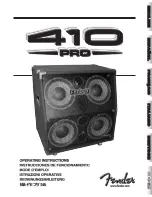
GE Analytical Instruments ©2016
215 of 270
DLM 68100-09 EN Rev. A
Chapter 9: Troubleshooting
External Inspection
•
Confirm that the display is illuminated.
•
Confirm that there are sufficient volumes of acid, oxidizer, dilution water, and check standard (if used) in
the carboys.
•
Confirm that there are no leaks present at the sample inlet, reagent inlets, dilution water inlet, Check
Standard inlet, or the waste connections. Ensure that the tubes for these tubes do not contain air or a
large volume of bubbles.
•
Confirm that there are no liquid leaks under the Analyzer.
•
Ensure that there is no paper or other material blocking the Reactor cooling air inlet on the bottom of
the Analyzer.
•
If you are experiencing erratic carbon readings, confirm that the pH of the waste stream is not too high.
The pH should equal 2 or less.
•
If the Analyzer is making measurements:
• And, if you are using a vial in the Vial Sampler, confirm that air bubbles enter the vial when the
Analyzer draws sample out of the vial.
• Confirm that gas is flowing from the Waste outlet of the Gas/Liquid Separator.
• Sample, dilution water, acid, and oxidizer should be drawn into the Analyzer periodically, unless
either the acid or oxidizer is set to 0%.
• Liquid waste should flow periodically from the Waste outlet. Insert the tube from the Waste Gas/
Liquid Separator port into a flask of water to confirm that gas is flowing.
• Confirm that the Reactor cooling air blows out Reactor Exhaust on the right side of the Analyzer
prior to each NPOC / TC measurement. The exhaust should be noticeably warm when the cooling air
starts flowing.
• If the optional Sample Peristaltic Pump is installed, confirm that it operates periodically and that
there are no leaks at its fittings or tubing.
• If the optional Filter Panel is installed, confirm that there are no leaks and that liquid flows to the
Analyzer periodically. Confirm that the blowback is operating correctly.
Internal Inspection
•
Check for leaks throughout the Analyzer; there should not be moisture on the inside of the Analyzer
case.
•
Confirm that the reagent, dilution water, and check standard tubes inside the Analyzer are full of liquid,
or contain only a few bubbles. If excessive bubbles are present, a flush should be performed. Look to
see if air flows into the reagent lines during flushing.
Содержание Sievers Innovox
Страница 214: ...GE Analytical Instruments 2016 214 of 270 DLM 68100 09 EN Rev A Chapter 9 Troubleshooting Figure 88 Analyzer Schematic ...
Страница 235: ...GE Analytical Instruments 2016 235 of 270 DLM 68100 09 EN Rev A Chapter 9 Troubleshooting Figure 104 Reactor Leak Check ...
Страница 248: ...GE Analytical Instruments 2016 248 of 270 DLM 68100 09 EN Rev A Figure 112 Analyzer Dimensions Right Side View ...
Страница 249: ...GE Analytical Instruments 2016 249 of 270 DLM 68100 09 EN Rev A Figure 113 Analyzer Dimensions Left Side View ...
Страница 250: ...GE Analytical Instruments 2016 250 of 270 DLM 68100 09 EN Rev A This page is intentionally left blank ...
Страница 258: ...GE Analytical Instruments 2016 258 of 270 DLM 68100 09 EN Rev A This page is intentionally left blank ...
Страница 264: ...GE Analytical Instruments 2016 264 of 270 DLM 68100 09 EN Rev A This page is intentionally left blank ...
Страница 268: ...GE Analytical Instruments 2016 268 of 270 DLM 68100 09 EN Rev A Index ...
Страница 269: ...GE Analytical Instruments 2016270 269 of 270 DLM 68100 09 EN Rev A Notes ...
Страница 270: ...GE Analytical Instruments 2016270 270 of 270 DLM 68100 09 EN Rev A Notes ...















































